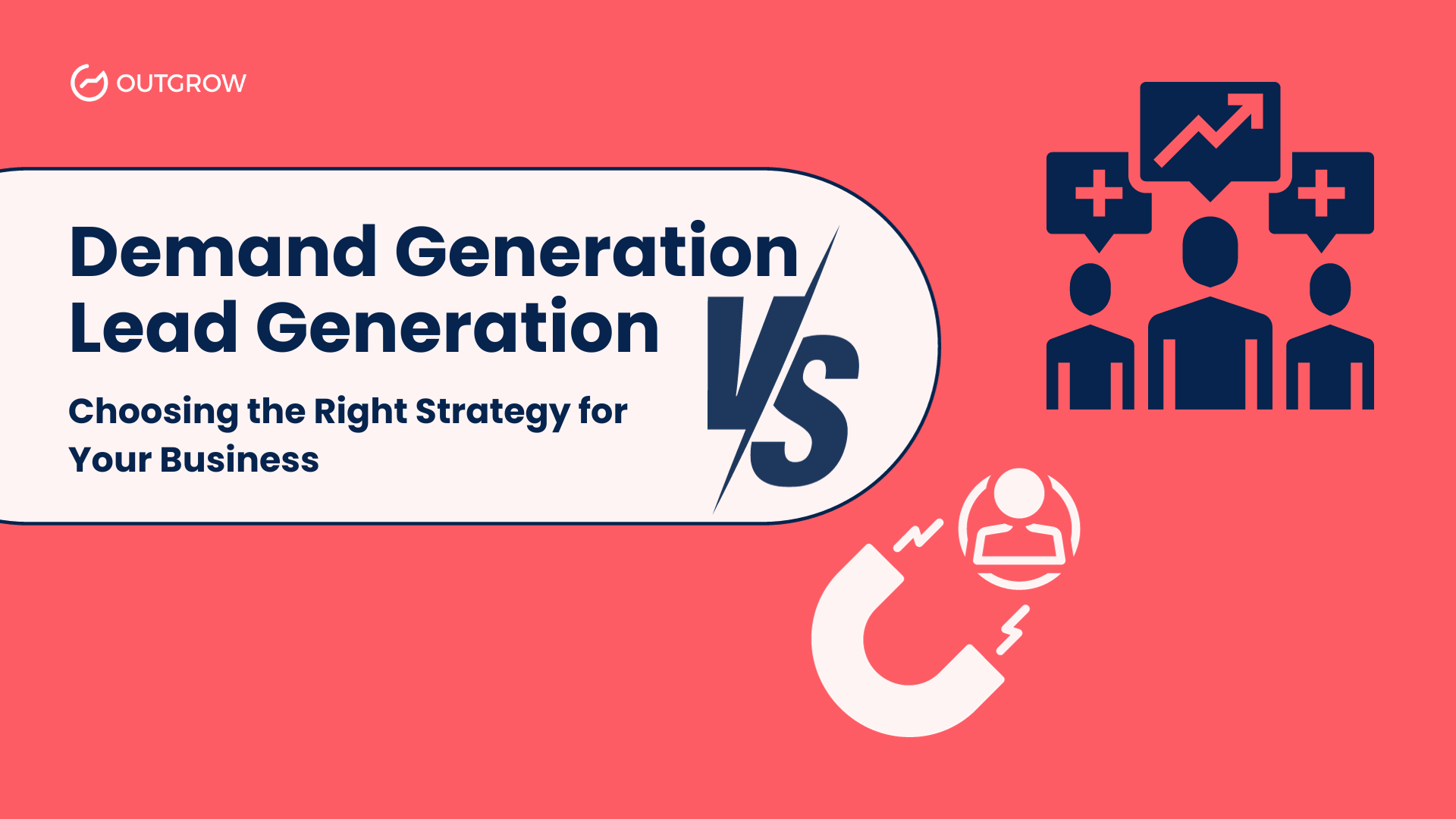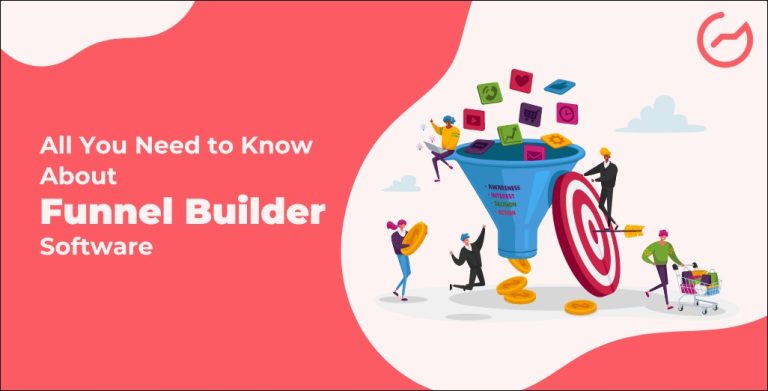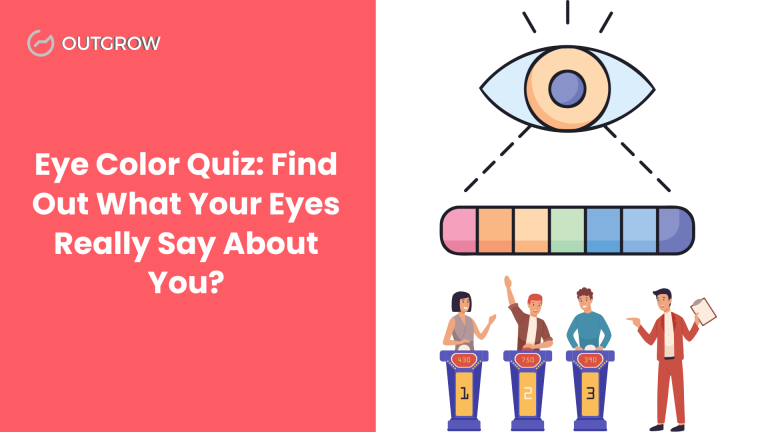Demand Generation vs Lead Generation: Choosing the Right Strategy for Your Business
Table of Contents
Demand generation and lead generation are often thought of as the same concept and used interchangeably by marketers. But in reality, these are the two different pillars of every successful marketing campaign. No matter what business you are in, both techniques have to go hand-in-hand. However, understanding the difference between demand generation vs lead generation is crucial to ultimately drive conversions and sales.
In this blog, we will understand the fundamentals of demand generation vs lead generation and how to use them tactically to form the right marketing strategy.
So, without further ado, let’s get to it!
What Is Demand Generation?
Demand generation is a marketing strategy that creates awareness, interest, and demand for a product or a service.
It aims to attract and engage potential customers, nurturing them through the buyer’s journey until they become paying customers. It involves a range of tactics, including content marketing, social media, SEO, events, webinars, etc., that generate interest and excitement around your offerings.
Unlike lead generation, which focuses solely on capturing the contact information of potential customers, demand generation has a broader scope. It aims to build brand authority, educate the audience, and establish a strong relationship with prospects even before they express a direct interest in purchasing.
By nurturing this early engagement and trust, demand generation sets the stage for effective lead nurturing and conversion in the long term.
Why Is Demand Generation Important?
Here are some key reasons why demand generation is so important:
Stronger brand awareness
Demand generation can help businesses build stronger brand awareness by increasing the visibility of their products or services. When people are already aware of the brand, they are more likely to consider it while making a purchase decision.
Competitive advantage
When businesses are able to generate more demand for their products or services than their competitors, they are more likely to win new customers and grow their business.
Reduced cost of acquisition
Effective demand generation can shorten sales cycles. When leads are nurtured with relevant content, they are more likely to make a purchase decision sooner. This, in turn, helps in reducing the cost of acquiring new customers.
What Is Lead Generation?
Lead generation is the process of identifying and attracting potential customers (leads) who have shown interest in your products or services. The primary objective of lead generation is to capture contact information, such as email addresses and phone numbers.
These leads are then nurtured and guided through the sales funnel with the goal of converting them into paying customers.
Lead generation involves various strategies and tactics aimed at building a pool of potential customers. It forms the foundation of customer acquisition and is a critical part of a company’s sales and marketing activities.
The goals of lead generation are centered around identifying and attracting potential customers, nurturing them through the sales funnel, and ultimately converting them into paying customers. Combining inbound and outbound lead generation strategies enhances your reach and effectiveness, creating a synergistic ‘push and pull’ effect that attracts and converts a broader spectrum of potential customers.
Why Is Lead Generation Important?
Here are some key reasons why lead generation is so important:
Enhanced Conversion Rate
By focusing on people who have already shown interest in a business’s product or service, businesses can nurture them with relevant content and offers, increasing the chances of those leads converting into paying customers. In turn, it increases your conversion rate.
Improved Lead Quality
Lead generation can also help you to identify which leads are most likely to be interested in your product or service and have the budget and authority to make the purchase. By targeting the right people with the right message, lead generation can help you to improve qualified leads and close more deals.
Improved Customer Segmentation
Lead generation can help you improve your customer segmentation by allowing you to collect data on your leads’ interests, demographics, and other factors. This information can be used to create more targeted marketing campaigns and offers, leading to higher conversion rates. By incorporating auto dialer software alongside a power dialer for sales calls, businesses can automate the calling process and gather valuable insights from each interaction.
Demand Generation vs Lead Generation
Demand generation vs lead generation, are both critical components of a comprehensive marketing strategy, but they focus on different stages of the customer journey and have distinct objectives. Here’s a breakdown of the critical differences between demand generation vs lead generation:
Objective
- Demand Generation: The primary objective of demand generation is to create awareness and interest in a company’s products or services. It aims to generate demand for what the company offers, even before the prospect is actively looking for a solution.
- Lead Generation: The main objective of lead generation is to identify potential customers who have shown interest in a company’s offerings. It aims to capture contact information from individuals who are more likely to convert into paying customers.
Content and Tactics
- Demand Generation: Utilizes a variety of content types, such as educational blog posts, thought leadership articles, webinars, ebooks, and industry reports. Tactics include content marketing, social media engagement, influencer partnerships, and events.
- Lead Generation: Involves content that encourages action, such as gated ebooks, whitepapers, webinars, free trials, and product demos. Tactics include landing pages, forms, chatbots, calls-to-action, and lead magnets.
Audience
- Demand Generation: Targets a wider audience that may include both potential customers and individuals who are not yet actively seeking a solution. It aims to educate and create interest among a broader group.
- Lead Generation: The primary aim is directed toward the customers who are already interested in your offerings which in turn increases the likelihood of them converting into paying customers.
Timing
- Demand Generation: Operates in the early stages of the buyer’s journey, creating awareness and consideration long before the prospect is ready to make a purchase decision.
- Lead Generation: Operates in the consideration and decision stages of the buyer’s journey, capturing leads from prospects who are closer to making a purchase.
Metrics
- Demand Generation: Metrics include website traffic, social media engagement, and content shares. Success is measured by an increase in brand recognition and audience engagement.
- Lead Generation: Metrics include the number of leads generated, conversion rates, lead quality, and return on investment (ROI). Success is measured by the number of qualified leads that convert into customers.
Creating a Successful Marketing Strategy with Lead Generation and Demand Generation
A successful marketing strategy requires a balanced blend of lead generation and demand generation tactics. While they serve specific purposes, combining these approaches can increase your brand’s reach, engagement, and conversions..
1. Define Your Goals
Begin by outlining specific goals for both lead generation and demand generation. Are you aiming to increase brand awareness, drive website traffic, or boost conversion rates? Clearly define what success looks like for each approach to guide your strategy.
For example
- Demand Generation – Increase website traffic by 30% within 6 months.
- Lead Generation – Generate 2000 leads within a month.
This is how you can set your specific goals for both demand generation and lead generation.
2. Know Your Audience
Understand the preferences, challenges, and behavioral patterns of your target audience. Demand generation efforts should resonate with a broader audience, while lead generation strategies should cater to those further down the funnel. Tailor your messaging and content accordingly.
You can do this by conducting thorough market research and mapping the customer journey. Understand where your customer stands in their journey and what information they require at each stage. This will guide your content creation and messaging.
3. Segmentation and Personalization
Segment your audience based on demographics, interests, and buying behavior. Create personalized content for demand generation to capture attention and for lead generation to nurture prospects through their journey.
You can do this by segmenting the audience in the following ways:
Audience Segmentation
- Demographics: Divide your audience based on characteristics like age, gender, location, occupation, etc.
- Interests: Group individuals with similar interests, hobbies, and preferences.
- Buying Behavior: Categorize based on how they engage with your brand, their purchase history, and their interaction with your content.
Creating Personas
Develop detailed buyer personas for each segment. A persona is a fictional representation of an ideal customer within a specific segment. Include information like their goals, challenges, motivations, and preferred communication channels.
4. Leverage Interactive Content
Develop a content strategy that aligns with both approaches. For lead generation, offer valuable gated content that encourages action. For demand generation, create interactive content that educates, entertains, and establishes your brand’s authority.
Interactive content grabs readers’ attention. It gives the customers a chance to express themselves, and that makes solving their issues easy.
Outgrow is an interactive platform offering simple, no-code tools to businesses that allow them to gain qualified leads with ease. They help create engaging and interactive content like quizzes, surveys, chatbots, and much more.
Look at this case study, for example. Leads.ph used Outgrow to create a quiz for their client to boost their brand awareness and demand generation. And guess what? – This quiz titled ‘Which Kind of Whisky Drinker Are You?’ got them a whopping 40000+ leads!
5. Landing Pages and Forms
Design captivating landing pages optimized for conversion. For lead generation, use strategically placed forms to capture contact information. Ensure your landing pages resonate with the audience’s intent and needs.
A good SEO campaign increases website traffic and a good website increases engagement.
Have a look at Netflix’s website. It has everything a user would want to know before signing up. The FAQ section is just enough to answer all the questions a prospect would have. Moreover, the clean and bold CTA is sureshot to grab attention.
6. Lead Scoring
Lead scoring refers to the act of allotting different points for different actions that prospects take on your website. Use lead scoring to measure a prospect’s engagement with you and then target them accordingly. Modern sales prospecting AI platforms take this further by automatically analyzing email responses, social interactions, and website behavior to prioritize leads most likely to convert. Prospects who are more engaged with your offerings are more likely to become your customers. Hence, they are given a much higher score.
7. Utilize Lead Magnets
Offer lead magnets such as ebooks, webinars, or exclusive industry insights to incentivize prospects to provide their information. These valuable resources can be powerful tools for both demand and lead generation.
Platforms like Outgrow let you ask questions from the audience that help you understand them better. When they answer your questions, you’ll know what to offer them. This will then help you identify your target product market easily.
For example, a health service provider can use a health assessment like: “How Healthy Are Your Eating Habits?” to attract leads and offer the right solution to the right customer.
8. Data and Analytics
Leverage data analytics tools to track the performance of your campaigns. Measure metrics such as website traffic, click-through rates, conversion rates, and lead quality. By consistently tracking these metrics and comparing them across different campaigns, you gain insights into what’s working and what needs adjustment.
You can refine your strategies based on this data, making informed decisions to enhance the performance of your future interactive content campaigns.
9. Continuous Optimization
Regularly analyze the results of your campaigns and make data-driven adjustments. Experiment with different tactics, channels, and content to find what works for your audience. A/B test various elements of your campaigns, such as headlines, calls-to-action, and visuals. Use the data gained from testing to refine your strategies for better results.
10. Monitor ROI
Measure the return on investment (ROI) for both lead generation and demand generation efforts. Compare the costs associated with each strategy against the revenue generated to assess their effectiveness. This includes expenses such as content creation, ad spending, tools or software used, and any additional resources invested.
Also, assess the revenue generated as a direct result of each strategy. For lead generation, track the revenue generated from the leads acquired through the campaign. For demand generation, evaluate the impact on sales and revenue growth.
Lead Generation as a Part of the Demand Generation Funnel
The lines between lead generation and demand generation have become increasingly blurred, creating an integrated approach that maximizes results.
Demand generation occurs at the initial stages of the sales funnel, where the primary goal is to raise awareness and capture the audience’s interest in your offerings. On the other hand, lead generation is centered around gathering details from potential prospects who have shown interest, with the aim of converting them into actual customers.
For example:
In order to generate awareness about your services, you can start with a SaaS assessment quiz like this. It can be used by a SaaS company to reach out to prospective customers at an early stage.
And, once the interest or demand has been generated, it’s time to get something actionable. Yep, we are talking about leads. And, in order to get some leads, it’s important to offer personalization.
Now, ROI calculators are a great way to attract leads as you are telling them how you can help them. We use this ROI calculator to help our prospects determine their return from using Outgrow even before they sign up. We get leads because we give them the real deal.
Let’s explore how lead generation has evolved to become an essential part of the demand generation journey:
1. Aligning Objectives
Traditionally, lead generation focused on capturing contact information, while demand generation aimed at creating brand awareness. Today, these strategies are aligned to enhance brand visibility and nurture meaningful connections with potential customers.
2. Elevating Awareness
Lead generation no longer works on its own. It’s integrated into the demand generation process, effectively reaching a wider audience and converting prospects into qualified leads through engaging content and experiences.
3. Nurturing Prospects
Demand generation lays the groundwork by creating an environment for lead generation. Engaged prospects who resonate with your brand’s messaging and content are more likely to transition into leads, showcasing a higher conversion rate.
4. Gated Content
Gated content, a staple of lead generation, now fits seamlessly into the demand generation funnel. Valuable resources like ebooks, webinars, and guides are strategically positioned to attract prospects and encourage them to provide their information.
5. Building Trust
Demand generation builds credibility and trust, making lead generation efforts more effective. When potential customers are already familiar with your brand, they are more inclined to share their details and engage with your offerings.
6. Tailored Experiences
The data gained from demand generation efforts allow for more personalized lead generation campaigns. This tailored approach resonates with prospects and increases the likelihood of conversion.
7. Capturing Intent
Demand generation identifies individuals who show interest in your industry. They are then aimed for lead generation efforts, as their intent aligns with your offerings.
8. Enriching Data
The data collected during lead generation enhances the understanding of your audience’s preferences and behaviors. This data helps to make demand-generation strategies more targeted and impactful.
Conclusion
Demand generation and lead generation form a combination that is essential for any revenue-driven marketing strategy. While demand generation focuses on enhancing brand awareness and creating interest, lead generation takes that interest forward and converts it into a desire for your products and services. Together, these strategies work hand in hand to create a pipeline of qualified leads.
And, the best part – you can perfect all these at one stop: Outgrow! With this all-rounder tool, you can create interactive content for your demand generation and lead generation strategy without any coding skills.
Did you know that interactive content boosts 2X engagement and conversions? Well, you do now. Take advantage of interactive content before your competition does. Start your free trial now!












